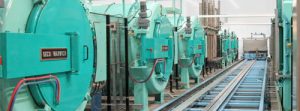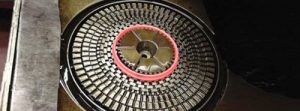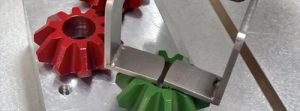
Finite element analysis (FEA) is widely used in mechanical design to predict part performance under various loading conditions. However, traditional loading models often assume uniform, isotropic, material properties and overlook the residual stresses and property changes introduced by heat treatment. This can be significant for case-hardened components such as gears or bearings. Heat treatment can alter phase composition, introduce compressive residual surface stresses, and change mechanical properties such as yield strength. Residual stresses in case-hardened parts develop due to complex interactions of phase transformation and temperature gradients during quenching. During quenching of carburized parts, martensite forms earlier in the low-carbon core than in the high-carbon case. This transformation sequence results in compressive stresses at the surface which are beneficial for fatigue performance. Figure 1 shows the stress reversals during a quench with (a) martensite transformation starting under the case, pushing the surface into tension and (b), residual compressive stresses at the surface after the case transforms.

The mechanical properties in the case are carbon and phase dependent and change from the surface to the core of the case-hardened part. Incorporating these effects into loading models is essential for accurate predictions of performance and service life. The main challenges of incorporating these properties from heat treatment are, first, accurately predicting the stress state and microstructure after heat treatment, and, second, to accurately map these results into loading models to better reflect real-world performance.
Building the Heat-Treatment Model
FEA models are highly dependent on the accuracy of the inputs. Figure 2 shows a graphic of the five general inputs needed to model heat treatment, and the three main outputs of the analysis.
First, a proper mesh is needed to capture the steep chemical, thermal, and phase transformation gradients present during heat treatment. In general, a fine layer of elements on the surface is required to capture the gradients well. Second, the heat transfer between the part and process equipment must be characterized and modeled correctly to accurately capture the part thermal and phase transformation profile. While conduction, convection, and radiation can all be simulated, many processes can be modeled using the ambient temperature and convective heat transfer coefficients (HTC).

During furnace heating, radiation can be included into an effective HTC. In quenching processes, the level of agitation and medium influences the cooling rate. For an oil or water quench, nucleate boiling should be accounted for through the process HTC.
The convective boundary condition varies depending on the process, and a gas quench process will behave differently compared with a liquid quench. Process time and temperature data can help determine the HTCs required for heat-treatment modeling. For chemical heat treatments, such as carburization or nitriding, material properties for diffusion, carbide or nitride formation, and dissolution are required. These models determine the chemical profile developed in the case and greatly contribute to the microstructure, distortion, and residual stresses generated from the process. Phase transformation kinetic models are required to capture the phase transformations and strain associated with these transformations during heat treatment. The transformational strain is a large part of the distortion and residual stress that develop during, and after, heat treatment, and accurately predicting the phase transformation timing is essential to predict these outputs.
Lastly, the mechanical properties of the steel change dramatically during heat treatment and are defined by the modulus, yield, and coefficient of thermal expansion, which are dependent on phase, carbon/nitrogen level, and temperature. Additionally, any plasticity during the process will need to be captured to predict the stress state and distortion after heat treatment.

Outputs
The outputs of a heat-treat model include microstructure, dimensional changes, and residual stress. Volume fractions of phases formed and combined hardness achieved are predicted. The distortion prediction is important for shape correction, scrap concerns, and for any post-heat treatment machining to help ensure that the developed case is not damaged. Finally, the residual stress prediction is paramount to the present work, and an accurate prediction can be used in subsequent loading models to determine the actual stress loaded parts will experience during service.
Workflow: From Heat Treatment to Loading
The general workflow for heat-treatment modeling with the finite element method considers a sequentially coupled analysis method, shown in Figure 3. First, a diffusion model is used to obtain the profile of carbon or nitrogen if carburizing or nitriding is performed. The developed carbon or nitrogen profile is then used in a thermal model to determine the temperature history the part experiences during heat treatment. Finally, a stress model is developed using these profiles and the thermal history from the first two models, which outputs the distortion, residual stress, and microstructure.
Once these outputs are achieved there are two pathways to consider for the loading models. One pathway is to directly map the residual stress to an implicit loading model. When using the DANTE material model, this method has the advantage of including the phases, carbon distribution, distortion, and mechanical properties developed from heat treatment.

The other pathway is to output the stress tensor as a separate file to map into a loading model with predefined mechanical properties. However, this method loses out on the phase and mechanical property effects developed during the heat treatment. A popular method for determining the residual stress redistribution during post-heat treatment machining is to map the model results into the machined geometry, allowing the analysis to redistribute the residual stress.
Validating the Heat-Treatment Model
Before residual stress results can be trusted in loading models, rigorous validation of the carbon profile, hardness, thermal history, phase distribution, distortion, and residual stress is required. Experimental characterization using simple sample geometries such as cylinders or bending specimens, are often used to validate model predictions. Carbon profiles can be measured with LECO or optical emission spectroscopy (OES). Thermal data can be collected with thermocouple probes embedded in actual parts or probes that accompany the parts during heat treatment. Phase analysis is generally performed with dilatometry, X-ray diffraction (XRD), or optical methods. Distortion is inspected before and after heat treatment with coordinate measuring machines (CMM). Finally, the residual stress is measured with XRD, or hole drilling or slitting methods using strain gauges. Once validated, these models can be used with confidence to explore the heat-treatment process and be used in further loading models.

Case Study: Gear Tooth Loading and Case Depth Effects
Objective
Examine how different carbon case depths affect residual stress and gear tooth bending performance.
Material and Process
- Material: Pyrowear 53.
- Low-pressure carburization (LPC) to 0.5mm, 1mm, and 1.5mm case depth.
- Oil quench hardening.
- Cryogenic treatment.
- Double temper.
Three case depths achieved by LPC were explored for their effect on the residual stress and loading performance in work performed in 2013 by Li, et al. [1]. Figure 4 shows the gear geometry used for this case study and the simulated carbon profile in the flank and root for the three case depths. One thing to note is the difference in surface carbon between the root and flank of the tooth from the LPC process. LPC uses a series of intermediate boost and diffuse steps to first build up carbon on the surface of the tooth and then diffuse steps allow the carbon to diffuse into the part. Due to the geometry, and the nature of diffusion, the root will have a reduced case depth and surface carbon compared to the flank. For this work, the case depth was defined on the flank of the tooth and the root shows the reduced case as expected.
After carburization, the oil quench, deep freeze, and double tempering steps were modeled and the residual stress distribution for the three case depths were analyzed. Figure 5 shows the simulated tangential stress path plots and contours in the root and flank. Overall, the simulations showed between 400 and 600 MPa of compression on the surface of the flank, with less compression in the deeper case compared to the shallower cases. Alternatively, the root fillet shows between 1,000 and 1,200 MPa in compression with a higher magnitude for the deeper case values. The stress contours show the minimum principal stress distribution within the part, illustrating the balance between tension and compression.

Loading Model
The residual heat-treat stress was mapped into a loading model where a load of 11 kN was applied to the tip of the tooth. This load was selected to achieve a bending load near the yield of the material, simulating an extremely low cycle fatigue response. The loading location and the path plot in Figure 6 show the applied stress profile in the gear root for the three case depths as well as the “stress free” condition for reference. In the stress-free condition, the applied stress peaks at about 1,800 MPa at the surface of the fillet, while the three conditions that included residual stress from heat treatment reduced the applied stress to about 900-1,000 MPa.
The shallowest case depth, 0.5 mm, also shows a tensile region just under the case reaching about 900 MPa, where the tension from heat treatment is added to the loading stress, causing an area of concern. This work illustrates the importance of modeling the residual stress from heat treatment as these results can be significant for case depth design and fatigue.
Conclusion
Standard loading simulations that ignore heat-treatment effects risk underestimating or overestimating part performance. Compressive residual stresses from case hardening can significantly offset applied tensile stresses, improving performance. By integrating detailed heat-treatment modeling, covering carbon diffusion, phase transformations, mechanical property variations, and residual stress into FEA loading models, engineers can achieve far more accurate predictions of component behavior under real-world loads.
Directly transferring heat-treatment results into loading models preserves critical gradients in carbon, phases, and mechanical properties. The DANTE simulation framework enables seamless integration of these steps, from carburization modeling to mapped loading analysis in Abaqus or Ansys.
Physical testing of carbon profiles, hardness, residual stress, and distortion validates the simulation and adds reliability. Modern workflows allow for mapping residual stresses to both distorted and machined geometries.
This approach not only predicts bending and contact stress performance, but also provides insights into the effects of overloads, machining-induced stress rebalancing, and distortion, making it a valuable tool for advanced mechanical design and failure prevention.
References
- Source: Li, Z., Freborg, A.M., Hansen, B.D. et al. Modeling the Effect of Carburization and Quenching on the Development of Residual Stresses and Bending Fatigue Resistance of Steel Gears. J. of Materi Eng and Perform 22, 664–672 (2013)























